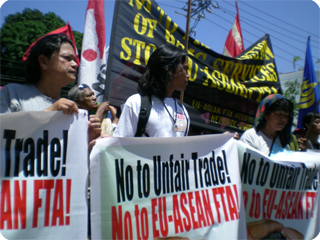Foreign ministers rekindle interest in EU-ASEAN FTA

ASEAN Briefing | 4 August 2014
Foreign ministers rekindle interest in EU-ASEAN FTA
Foreign ministers attending the 20th EU-ASEAN Ministerial Meeting in Brussels last week have raised the possibility of resuming negotiations for an EU-ASEAN free trade agreement (FTA) once the ASEAN Economic Community comes into effect at the end of 2015.
ASEAN and the EU originally launched negotiations for a region-to-region FTA in 2007, but following seven rounds of negotiations the plans were quietly dropped in March 2009, largely as a result of political disagreements over Myanmar’s human rights record and political regime. The ‘Myanmar problem’ has long been a stumbling block for EU-ASEAN relations, to the extent that the EU-ASEAN Ministerial Meetings were suspended for several years in the 1990s as a result of the issue.
During the previous negotiations for an ASEAN-EU FTA, it was proposed that the agreement would cut or eliminate existing tariff and non-tariff barriers in order to increase trade and investment between the two sides. According to some estimates, ASEAN exports to the EU would have increased by more than 18.5 percent as a result, representing a two percent boost to ASEAN’s GDP by 2020. EU exports would also benefit, albeit not so dramatically, with an expected two percent increase.
The dissolution of the ASEAN-EU FTA negotiations resulted in a change in the nature of economic ties between the two blocs, with the EU instead deciding to pursue bilateral FTAs with individual ASEAN countries.
Singapore became the first ASEAN country to conclude FTA negotiations with the EU in December 2012. The FTA, which is yet to be ratified, will allow duty-free access on all EU imports into Singapore as well as gradually abolishing tariffs on all Singaporean products imported into the EU over the next five years.
Three sets of negotiations are currently underway regarding FTA talks between the EU and Malaysia, Vietnam and Thailand, and it is expected that these FTAs, along with the EU-Singapore agreement, will eventually be used as the basis for a rejuvenated region-to-region FTA.
Despite the failed ASEAN-EU FTA, economic relations between the two blocs have gone from strength to strength. Trade has increased every year for the past five years – ASEAN is now the EU’s third largest trading partner and the EU is ASEAN’s fifth largest. Moreover, the EU is ASEAN’s biggest foreign investor, constituting approximately one-third of ASEAN’s foreign direct investment. Undoubtedly these economic ties would strengthen further should the two blocs take additional steps towards more advanced economic integration.
In addition to trade and investment, the two blocs have enjoyed cooperation in a range of other spheres over the years, including political and cultural initiatives. Nevertheless, EU-ASEAN relations are still relatively weak in comparison with the relationship between ASEAN and India, China, the U.S. and Australia.
The EU and ASEAN both stand to gain from the resumption of FTA talks, a possibility made feasible as a result of the EU lifting the last of its individual, trade and economic sanctions against Myanmar, an action which improved EU-ASEAN relations and effectively removed the main hurdle to previous attempts at a region-to-region FTA.
From ASEAN’s point of view, an EU-ASEAN FTA could entice the investment that is drastically needed to upgrade its member countries’ infrastructure. The FTA would also bring economic benefits to European countries by making it easier for them to seize the opportunities brought about by rapid Asian growth, as well as being a good move for prestige by increasing the EU’s role within the region.
It is still too early to speculate about the possible path of future negotiations of the EU-ASEAN FTA and the ramifications thereof, but analysts will undoubtedly be keenly observing upcoming meetings between the two sides in Myanmar in August and Milan in October to see whether the FTA will be discussed, and in what capacity.





